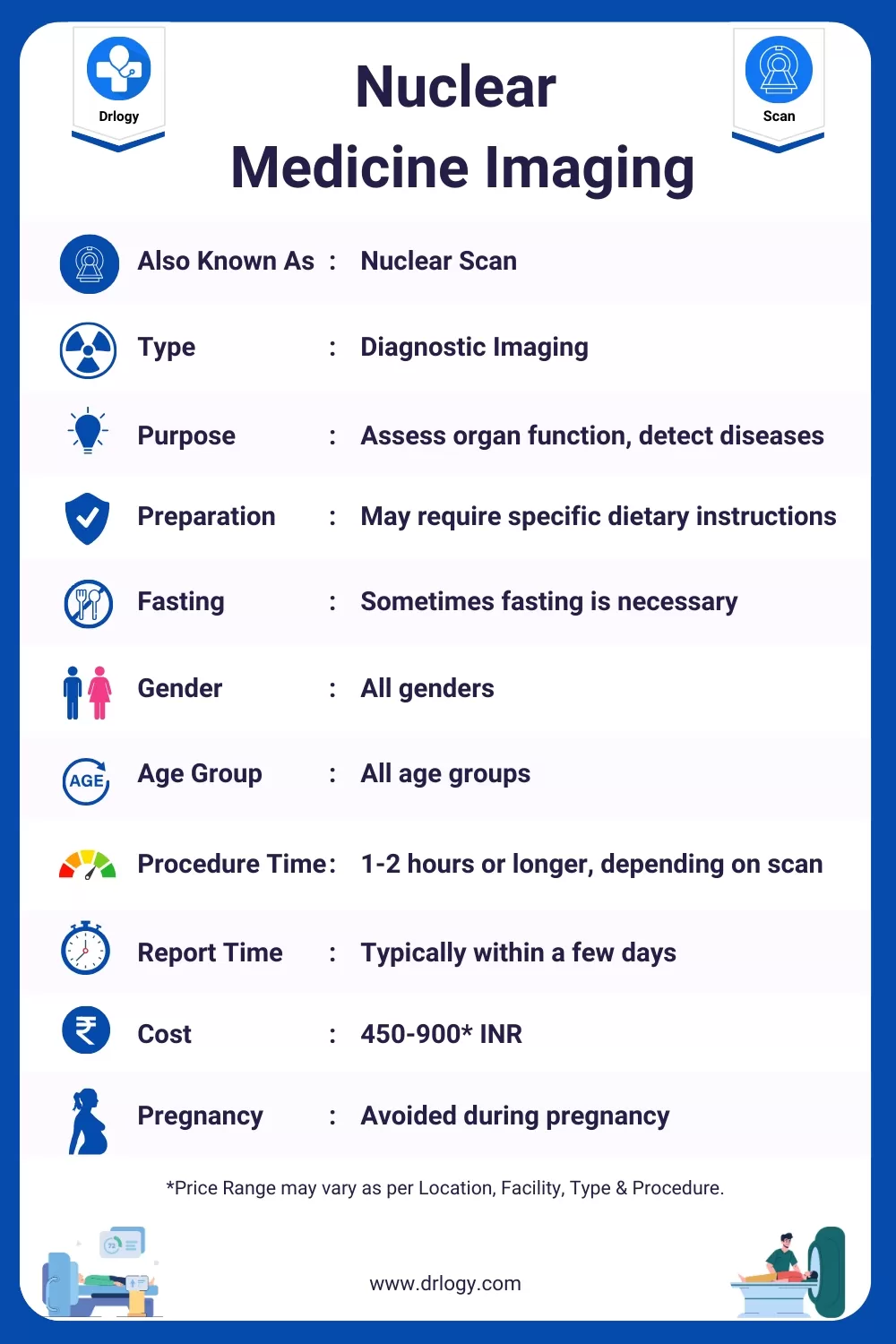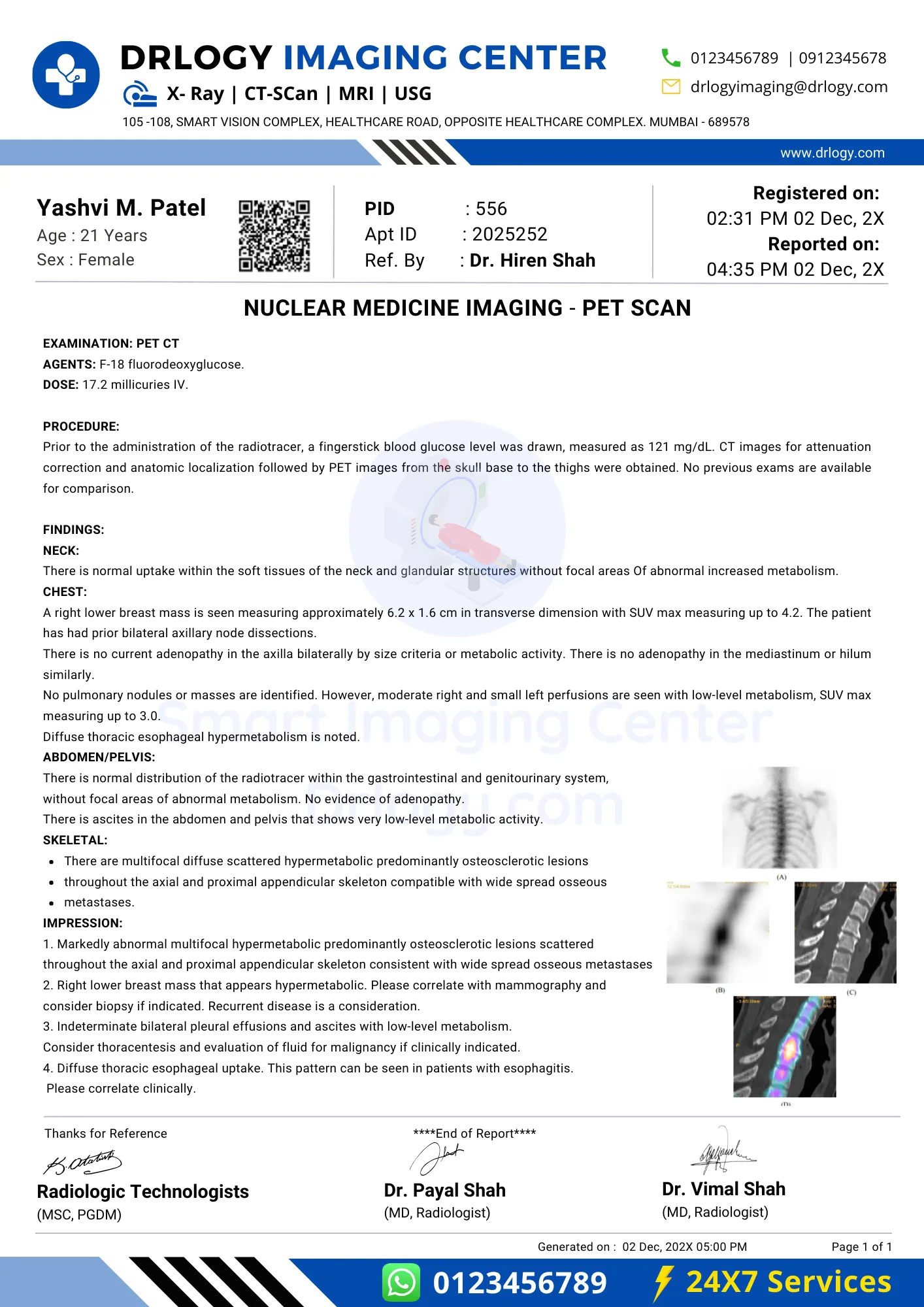
Nuclear medicine imaging is a medical technique that uses small amounts of radioactive materials to diagnose and evaluate various diseases by capturing images of how these substances interact with the body's tissues and organs.
Nuclear medicine imaging is a medical imaging technique.
Here are the basic details for the Nuclear Medicine Imaging .
| Also Known As | Nuclear Scan |
| Type | Diagnostic Imaging |
| Purpose | Assess organ function, detect diseases |
| Preparation | May require specific dietary instructions |
| Fasting | Sometimes fasting is necessary |
| Gender | All genders |
| Age Group | All age groups |
| Procedure Duration | 1-2 hours or longer, depending on the scan |
| Reporting Time | Typically within a few days |
| Cost | 450-900* INR |
| Pregnancy Consideration | Avoided during pregnancy |
| Risks and Safety | Low radiation exposure, generally safe |
| Accessibility | Available in specialized medical centers |
*Price range may vary as per location, facility, type, and procedure.
Here are common reasons for Nuclear Medicine Imaging.

Here are the types of Nuclear Medicine Imaging along with their primary use.
| Nuclear Medicine Imaging | Organ/System | Primary Use |
|---|---|---|
| Bone Scan | Skeleton | Detect bone abnormalities |
| Thyroid Scan | Thyroid gland | Assess thyroid function |
| Cardiac Perfusion Scan | Heart | Evaluate cardiac blood flow |
| PET/CT Scan | Various | Detect metabolic activity |
| Gallium Scan | Whole body | Detect inflammation or tumors |
| Renal Scan | Kidneys | Evaluate kidney function |
| Hepatobiliary Scan | Liver/Gallbladder | Assess liver and bile ducts |
| Lung Ventilation/Perfusion Scan | Lungs | Assess lung function |
| Octreotide Scan | Various | Detect neuroendocrine tumors |
These nuclear medicine imaging types provide valuable insights into specific organs and conditions.
Here is the basic preparation before, during, and after Nuclear Medicine Imaging for any patient.
Please note that the specific instructions and procedures can vary based on the type of nuclear medicine scan you are undergoing and your individual medical condition. Always follow the guidance provided by your healthcare team for a successful and safe nuclear medicine imaging procedure.
| Professional | Role |
|---|---|
| Nuclear Medicine Technologist | Administers radioactive substances, operates imaging equipment. |
| Radiologic Technologist | Assists during the procedure and helps with patient positioning. |
| Radiologist | Interprets nuclear medicine images, provides a diagnosis. |
The procedure for Nuclear Medicine Imaging typically follows these steps:
Here are some common elements you might find in a Nuclear Medicine Imaging report:
| Nuclear Medicine Imaging Findings | Interpretation |
|---|---|
| Procedure (e.g., PET, SPECT, etc.) | Description of the imaging technique used |
| Radiotracer Uptake | Areas of increased or decreased radiotracer uptake |
| Specific Area or Organ | Location or organ system being assessed |
| Quantitative Measurements | Quantitative values, if applicable (e.g., standardized uptake values in PET) |
| Functional Information | Assessment of metabolic or functional activity |
| Impression | Summary of key findings or diagnostic impressions |
| Recommendations | Follow-up tests, treatments, or further evaluation, if necessary |
| Conclusion | Final remarks or clinical recommendations |
Please note that the format and content of nuclear medicine imaging reports can vary depending on the specific procedure and the clinical context. Interpretation of these findings should be done by a qualified nuclear medicine specialist or healthcare professional.
Here is potential causes of abnormal nuclear medicine imaging results:
| Abnormal Nuclear Medicine Finding | Potential Causes |
|---|---|
| Increased Radiotracer Uptake | Cancer, infection, inflammation, metabolic disorders |
| Decreased Radiotracer Uptake | Poor blood flow, tissue damage, dysfunction |
| Altered Organ Function | Organ dysfunction, disease, metabolic changes |
| Abnormal Localization | Abnormal tissue growth, lesions, anomalies |
| Unusual Distribution | Congenital abnormalities, unusual physiological processes |
| Impaired Clearance | Kidney or liver dysfunction, metabolic disorders |
Abnormal nuclear medicine imaging findings are complex and require careful evaluation by a qualified nuclear medicine specialist or healthcare provider to determine the underlying cause and appropriate next steps for diagnosis and treatment.
The duration of a nuclear medicine imaging procedure can vary depending on the specific type of scan and the purpose of the examination. Here's a general overview of the approximate time it takes for different types of nuclear medicine imaging procedures:
| Nuclear Medicine Imaging Procedure | Duration |
|---|---|
| Bone Scan | 1-3 hours (including waiting time for radiotracer uptake) |
| Thyroid Scan (Thyroid Uptake and Scan) | 2-3 hours (including waiting time) |
| Cardiac Perfusion Scan (Myocardial Perfusion Imaging) | 1-4 hours (may include exercise or pharmacological stress) |
| PET/CT Scan (commonly used) | 1-2 hours |
| Gallium Scan | 1-2 hours |
| Renal Scan (DMSA or MAG3) | 1-2 hours |
| Hepatobiliary Scan (HIDA or DISIDA) | 1-2 hours |
| Lung Ventilation/Perfusion Scan | 1-2 hours |
| Octreotide Scan (Somatostatin Receptor Scintigraphy) | 1-2 hours |
- Please note that these are approximate times and can vary depending on factors such as the specific radiotracer used, the patient's specific condition, and the imaging equipment's capabilities.
- Additionally, some nuclear medicine scans may require additional preparation time, such as allowing the radiotracer to circulate in the body before imaging.
- Always follow the instructions provided by your healthcare provider for your specific nuclear medicine imaging procedure.

Here are some limitation associated with a Nuclear Medicine Imaging.
Here are some risk factors associated with a Nuclear Medicine Imaging
| Myth | Reality |
|---|---|
| High radiation risk | Low radiation exposure |
| Dangerous for all | Specific medical conditions |
| Harmful for all | Risk factors considered |
| Causes side effects | Generally well-tolerated |
| Permanent effects | Temporary radiation |
| Not for children | Used in pediatric medicine |
| Always invasive | Varies by procedure |
Here are the estimated Nuclear Medicine Imaging Price in India with different top cities:
| City | Price Range (INR)* |
|---|---|
| Mumbai | 450 - 900 |
| New Delhi | 500 - 900 |
| Bangalore | 450 - 900 |
| Hyderabad | 500 - 900 |
| Kolkata | 450 - 900 |
| Pune | 500 - 900 |
| Lucknow | 450 - 900 |
| Noida | 500 - 900 |
| Surat | 500 - 900 |
| Gurugram | 450 - 900 |
| Patna | 450 - 900 |
| Chennai | 500 - 900 |
| Jaipur | 500 - 900 |
| Ahmedabad | 450 - 900 |
*Prices are approximate and range may vary as per location, facility, type, and procedure.
Summary
Overall, Nuclear Medicine Imaging offers valuable insights into medical conditions using small amounts of radioactive material and is generally safe when managed by trained professionals. Also check Drlogy Test for detailed information about all medical tests for patients, doctors, scholers and medical students.
Reference
DOCTOR'S MOST TRUSTED HEALTHCARE PLATFORM
10M+Patients
30000+Doctors
25000+Hospitals/Labs